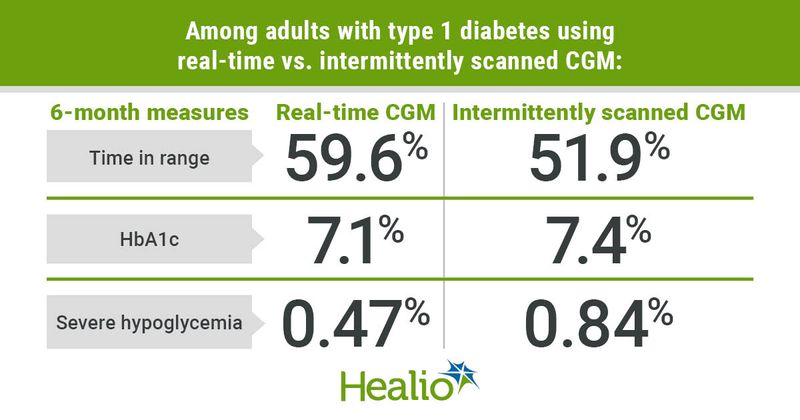Switch from intermittent to real-time CGM improves time in range, quality of life measures
Click Here to Manage Email Alerts
Adults with type 1 diabetes who switched from intermittently scanned to real-time continuous glucose monitoring saw improved time in range and quality of life measures at 6 months compared with those who did not make the change, data show.

“This study answers an important clinical question: Namely, do we have to give people with type 1 diabetes a CGM system with or without alerts?” Pieter Gillard, MD, PhD, assistant head of clinic in the department of endocrinology at University Hospitals Leuven and associate professor at the University of Leuven in Belgium, told Healio. “The results of our study indicate that clinicians should consider real-time CGM with alerts instead of intermittently scanned CGM without alerts to improve their health and quality of life.”

In a prospective, double-arm, parallel-group, randomized controlled trial, Gillard and colleagues analyzed data from 254 adults with type 1 diabetes across six hospitals in Belgium who previously used intermittently scanned CGM (mean age, 43 years; 94% white; 81% using multiple daily injection therapy). Researchers randomly assigned participants to real-time CGM (n = 127) or continued use of intermittently scanned CGM (n = 127; controls). Participants, investigators and study teams were not masked to group allocation. Primary endpoint was mean between-group difference in time in range at 6 months, assessed in the intention-to-treat sample. The findings were presented at the virtual International Conference on Advanced Technologies & Treatments for Diabetes and simultaneously published in The Lancet.
At baseline, most participants performed frequent CGM scanning (median, 11 scans daily). Mean baseline HbA1c was 7.4% and mean baseline time in range was 51.9%, with 17% of participants experiencing hypoglycemia unawareness.
After 6 months, time in range was higher for participants in the real-time CGM group compared with controls, with rates of 59.6% vs. 51.9%, respectively (mean difference, 6.85 percentage points; 95% CI, 4.36-9.34).
HbA1c was lower for the real-time CGM group compared with controls at 6 months, with mean HbA1c levels of 7.1% vs. 7.4%, respectively (P < .0001). Participants in the real-time CGM group also spent less time in severe hypoglycemia compared with controls, defined as 54 mg/dL (0.47% vs. 0.84%; P = .007).
Mean scores for the Hypoglycemia Fear Survey-II worry subscale were also lower for the real-time CGM group (mean, 15.4 vs. 18; P = .0071).
Researchers found that fewer participants using real-time CGM experienced severe hypoglycemia compared with controls (3 vs. 13; P = .0082).
“People using real-time CGM were generally better able to keep their glucose levels in check than people using a first-generation, intermittently scanned CGM without alerts,” Gillard told Healio. “On average, their readings were longer in range, resulting in significant decrease in Hb1Ac and less time in severe hypoglycemia. In addition, questionnaires told us that they experienced less worry about hypoglycemia and were more satisfied with real-time CGM. I believe most colleagues would have expected that real-time CGM with alert functionality would result in those outcomes, but until now, this was never proven in a robust trial.”
Gillard noted that participants were free to adapt the alert setting of their real-time CGM; only the “urgent low” alert could not be turned off.
“We observed that more than 90% of people on real-time CGM kept one or more alerts turned on, so we did not observe ‘alarm fatigue’ for high- or low-alert settings,” Gillard said. “Only for the rise or fall rate alerts we observed less people that kept those alerts on.”

